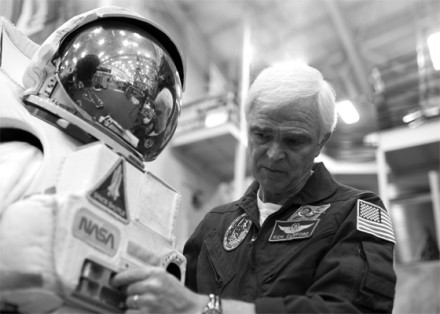Along the way: BCM Report’s astronaut

Along the Way is Thinkso’s ongoing series that highlights some of the people, places and things we are privileged to experience in our work as designers.
Thinkso has had the pleasure of collaborating with Baylor College of Medicine on their institutional communications for the past two years. We are proud of the work we’ve done for them and prouder yet to contribute in some small way to the amazing work they do in the field of medicine.
Working on the latest issue of The BCM Report, we met and photographed Space Shuttle astronaut Rich Clifford (STS-53, 59, 76). It was really cool and inspiring to work with a real, live astronaut, so we’d like to share part of the report’s article, written by Debra Passner, Executive Director of Academic Marketing and Communications at Baylor College of Medicine.
“It was just past midnight on March 14, 1996. I began the day strapped into the crew compartment and I could hear the voice of launch control counting off the seconds until finally I heard, “3, 2, 1 and liftoff of the shuttle Atlantis on a mission to the Russian MIR space station.” That pre-dawn launch was my third space shuttle mission as a United States Astronaut. It was, however, my first mission to space after being diagnosed with early Parkinson’s disease.
These words are the opening to astronaut Rich Clifford’s notice to the world that he not only suffered from Parkinson’s disease, but that he was able to fly successful space missions, including a planned space walk on the MIR space station, after his diagnosis. Six months after his second space mission Clifford mentioned a problem with his right shoulder during his annual flight physical. NASA doctors immediately took him to the Parkinson’s Disease Center and Movement Disorders Clinic at BCM, which is recognized as a center of excellence by the National Parkinson Foundation and the Huntington’s Disease Society of America. Dr. Joseph Jankovic, director of the Center and professor of neurology at BCM, informed Clifford that he had Parkinson’s disease.“So many things went through my head when I began to learn more about my condition, but I was resolute and determined not to let it affect my outlook,” said Clifford. “I wanted to remain an astronaut.”
Jankovic has led several pioneering studies of new therapeutics for Parkinson’s disease and published over 800 articles and 50 books on the disease and related movement disorders. He developed a treatment plan that would control Clifford’s symptoms so that he was not only able to continue to fly, he was even able to successfully complete physically demanding space walks. One of the medications that helped Clifford was rasagiline (brand name Azilect), which was one of the drugs Jankovic’s research helped bring to market. “Our goal in treatment for all patients, including Rich, is to balance medications so that we can optimize symptomatic relief while minimizing side effects that might limit their abilities,” said Jankovic.
Clifford left the astronaut ranks in 1997 for reasons not associated with Parkinson’s disease. “The disease has progressed,” said Clifford. “But its acceleration is following a very low ramp, thanks to the help of Dr. Jankovic and others as well as continued advances in Parkinson’s disease research.”
Since going public with his condition, Clifford has become a leading advocate for Parkinson’s disease. He is the 2012 recipient of the Public Leadership in Neurology Award from the American Academy of Neurology (AAN) and its Foundation. He is also the subject of an upcoming documentary film The Astronaut’s Secret.